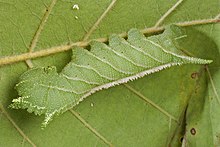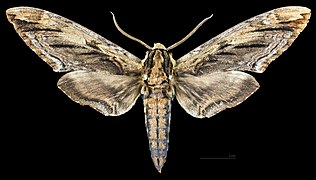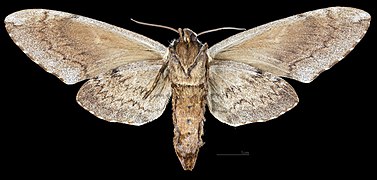Ceratomia amyntor
| Ceratomia amyntor | ||||||||||||
|---|---|---|---|---|---|---|---|---|---|---|---|---|

Ceratomia amyntor |
||||||||||||
| Systematics | ||||||||||||
|
||||||||||||
| Scientific name | ||||||||||||
| Ceratomia amyntor | ||||||||||||
| ( Geyer , 1835) |
Ceratomia Amyntor is a butterfly ( moth ) from the family of moth (Sphingidae). The species colonizes large parts of North America.
features
The moths have a fore wing length of 47 to 57 millimeters. The moths are very variable in their pattern. There are animals with very little contrast and those in which the pattern is very well developed. Some animals are so dark that they appear almost black. The costal area on the front wing of the animals is gray, the subcostal area yellowish-brown. These areas clearly stand out from the dark brown medial area, making the species easy to distinguish from the other species of the genus Ceratomia . The proboscis reaches a length of 13 millimeters. The species also has dark lines along the wing veins and a white point in the cell. The hind wings are light brown on the upper side and have a dark brown band on the outer edge.
The caterpillars come in several color variations, ranging from green to dark brown. There are also orange-brown animals, sometimes with a pink shimmer. They have conspicuous, fleshy "horns" with many white secondary bristles on their thorax . The species owes its English name "Four-horned Sphinx" to this feature, the other name "Elm Sphinx" refers to the main food plant. Two spiked grooves run along the back. The anal horn has a very grainy structure. The caterpillars have seven diagonal white stripes on their sides that begin at the base of one segment and end at the next segment.
The doll is maroon and has a smooth surface. Your proboscis sheath is fused and the abdominal segments are severely constricted. The broad, rough cremaster ends with a small double point.
Occurrence
The species colonizes large parts of North America. It is common in the United States from New England to northern Florida and west to central New Mexico and Colorado. In 2005, one specimen was found in the extreme southeast of Arizona. Although there is no evidence from Wyoming and Montana, it is believed that the species is equally common there in the east. In Canada, the species is distributed to the east in Nova Scotia, New Brunswick and southern Québec. In Ontario, they are found on the Niagara Peninsula and along the northern shores of the Great Lakes. The species has also been found in southern Manitoba and west to Saskatchewan and south-east Alberta. In the south, the range of the species extends along the Gulf Coast to Texas, New Mexico and Mexico.
Ceratomia amyntor inhabits deciduous forests. In the east of the range the species occurs frequently, in the west it is only found locally in forest areas. It is more common in the north of the area than in the south.
Way of life
The moths fly to light sources at night. Despite its short length, your proboscis would be suitable for feeding, but it is not known whether the muscles are trained to do so. Evidence of the moths on nectar plants could only be provided by CH Fernald (1884) so far. However, Eliot and Soule documented in 1902 that the moths are attracted by light, bait and flowers, which is why one can assume that they are able to ingest nectar despite the lack of further evidence.
Flight and caterpillar times
In the north of the range, the species flies in one generation in the summer in June and July. In the south, at least two generations fly from April to October, for example in Missouri. However, there are authors who even assume five generations in this period, which shows that the flight times of the species have not yet been adequately researched.
Food of the caterpillars
The caterpillars feed mainly on elms ( ulmus ). In Canada and in the states around New England they have also been found on linden and birch ( Betula ), they are also said to eat common locust ( Robinia pseudoacacia ) and Prunus species.
development
The females lay their bright, light green eggs individually on the leaves of the host plants. The caterpillars live solitary and need four to five weeks for the first stage. Pupation takes place in a chamber several centimeters deep in the ground. The pupae overwinter.
supporting documents
Individual evidence
- ↑ a b c d e f g h i j k James P. Tuttle: The Hawkmoths of North America, A Natural History Study of the Sphingidae of the United States and Canada. The Wedge Entomological Research Foundation, Washington, DC 2007, ISBN 978-0-9796633-0-7 .
- ↑ a b c d e f g h Sphingidae of the Americas. Bill Oehlke, accessed December 28, 2011 .
- ↑ Fernald, CH 1884: Notes on Sphingidae captured at Orono, Maine, and vicinity. Can. Ent. 16: pp. 21-22
literature
- James P. Tuttle: The Hawkmoths of North America, A Natural History Study of the Sphingidae of the United States and Canada. The Wedge Entomological Research Foundation, Washington, DC 2007, ISBN 978-0-9796633-0-7 .




